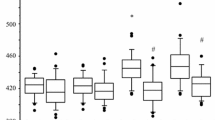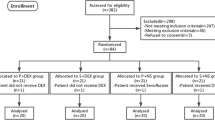Abstract
We investigated the effect of intravenous premedication with single dose of dexmedetomidine (DEX) on volatile anesthetic induction time and sevoflurane requirements of anesthesia maintenance in adults by monitoring the bispectral index (BIS). Sixty adult patients with status of ASA I–II undergoing general anesthesia with endotracheal intubation were randomly divided into two groups: The first group; a control group (group C, n = 30) and the second group; DEX group (group D, n = 30). Each patient in group D was premedicated with intravenous DEX 0.5 μg/kg or placebo 10 min before the induction of anesthesia. Anesthesia was induced by fentanyl 1 μg/kg, 1:1 ratio of nitrous oxide and oxygen and sevoflurane of 5–8 % and rocuronium bromur (Esmeron) 0.5 mg/kg keeping BIS values at 40–50. Time to induction of anesthesia, BIS, End-tidal sevoflurane concentration (Etsevoflurane), End-tidal CO2 concentration, duration of surgery, recovery time, hemodynamic variables, adverse effects were recorded intraoperatively. Analgesic requirement was noted in postoperative 24 h-period. The time to induction of anesthesia (p < 0.0001) and Etsevoflurane at 1 min (p < 0.05) were significantly lower in group D than in group C. Intravenous premedication with 0.5 μg/kg of DEX decreased the induction time by almost 75 % and provided a significant decrease in Etsevoflurane.


Similar content being viewed by others
References
Yurino M, Kimura H. A comparison of vital capacity breath and tidal breathing techniques for induction of anaesthesia with high sevoflurane concentrations in nitrous oxide and oxygen. Anaesthesia. 1995;50:308–11.
Hall JE, Stewart JI, Harmer M. Single-breath inhalation induction of sevoflurane anaesthesia with and without nitrous oxide: a feasibility study in adults and comparison with an intravenous bolus of propofol. Anaesthesia. 1997;52:410–5.
Hattori J, Yamakage M, Iwasaki S, et al. Usefulness of midazolam premedication for volatile induction of anesthesia in adults. J Anesth. 2001;15:117–9.
Yamakage M, Tsuchiya S, Ohtsuka N, Iwasaki S, Namiki A. Usefulness of oral hypnotic premedication for volatile induction of anesthesia in adults. J Anesth. 2002;16:194–7.
Lamberty JM, Wilson IH. Single breath induction of anaesthesia with isoflurane. Br J Anaesth. 1987;59:1214–8.
Ruffle JM, Snider MT, Rosenberger JL, Latta WB. Rapid induction of halothane anaesthesia in man. Br J Anaesth. 1985;57:607–11.
Ruffle JM, Snider MT. Comparison of rapid and conventional inhalation inductions of halothane oxygen anesthesia in healthy men and women. Anesthesiology. 1987;67:584–7.
Strum DP, Eger EI 2nd. Partition coefficients for sevoflurane in human blood, saline, and olive oil. Anesth Analg. 1987;66:654–6.
Scheller MS, Saidman LJ, Partridge BL. MAC of sevoflurane in humans and the New Zealand white rabbit. Can J Anaesth. 1988;35:153–6.
Taguchi M, Watanabe S, Asakura N, Inomata S. End-tidal sevoflurane concentrations for laryngeal mask airway insertion and for tracheal intubation in children. Anesthesiology. 1994;81:628–31.
Kimura T, Watanabe S, Asakura N, et al. Determination of end-tidal sevoflurane concentration for tracheal intubation and minimum alveolar anesthetic concentration in adults. Anesth Analg. 1994;79:378–81.
Yurino M, Kimura H. Vital capacity rapid inhalation induction technique: comparison of sevoflurane and halothane. Can J Anaesth. 1993;40:440–3.
Maze M, Tranquilli W. Alpha-2 adrenoceptor agonists: defining the role in clinical anesthesia. Anesthesiology. 1991;74:581–605.
Salonen MA, Kanto JH, Maze M. Clinical interactions with alpha-2-adrenergic agonists in anesthetic practice. J Clin Anesth. 1992;4:164–72.
Inomata S, Yaguchi Y, Toyooka H. The effects of clonidine premedication on sevoflurane requirements and anesthetic induction time. Anesth Analg. 1999;89:204–8.
Aantaa RE, Kanto JH, Scheinin M, Kallio AM, Scheinin H. Dexmedetomidine premedication for minor gynecologic surgery. Anesth Analg. 1990;70:407–13.
Scheinin B, Lindgren L, Randell T, Scheinin H, Scheinin M. Dexmedetomidine attenuates sympathoadrenal responses to tracheal intubation and reduces the need for thiopentone and peroperative fentanyl. Br J Anaesth. 1992;68:126–31.
Buhrer M, Mappes A, Lauber R, Stanski DR, Maitre PO. Dexmedetomidine decreases thiopental dose requirement and alters distribution pharmacokinetics. Anesthesiology. 1994;80:1216–27.
Aantaa R, Jaakola ML, Kallio A, Kanto J. Reduction of the minimum alveolar concentration of isoflurane by dexmedetomidine. Anesthesiology. 1997;86:1055–60.
Katoh T, Suzuki A, Ikeda K. Electroencephalographic derivatives as a tool for predicting the depth of sedation and anesthesia induced by sevoflurane. Anesthesiology. 1998;88:642–50.
Sigl JC, Chamoun NG. An introduction to bispectral analysis for the electroencephalogram. J Clin Monit. 1994;10:392–404.
Song D, Joshi GP, White PF. Titration of volatile anesthetics using bispectral index facilitates recovery after ambulatory anesthesia. Anesthesiology. 1997;87:842–8.
Bonhomme V, Hans P. Monitoring the depth of anaesthesia: why, how and at which cost? Rev Med Liege. 2007;62 Spec No:33–9.
Correa-Sales C, Rabin BC, Maze M. A hypnotic response to dexmedetomidine, an alpha 2 agonist, is mediated in the locus coeruleus in rats. Anesthesiology. 1992;76:948–52.
Correa-Sales C, Nacif-Coelho C, Reid K, Maze M. Inhibition of adenylate cyclase in the locus coeruleus mediates the hypnotic response to an alpha 2 agonist in the rat. J Pharmacol Exp Ther. 1992;263:1046–9.
Maksimow A, Snapir A, Sarkela M, et al. Assessing the depth of dexmedetomidine-induced sedation with electroencephalogram (EEG)-based spectral entropy. Acta Anaesthesiol Scand. 2007;51:22–30.
Ghignone M, Quintin L, Duke PC, Kehler CH, Calvillo O. Effects of clonidine on narcotic requirements and hemodynamic response during induction of fentanyl anesthesia and endotracheal intubation. Anesthesiology. 1986;64:36–42.
Ghignone M, Calvillo O, Quintin L. Anesthesia and hypertension: the effect of clonidine on perioperative hemodynamics and isoflurane requirements. Anesthesiology. 1987;67:3–10.
Kaukinen S, Pyykko K. The potentiation of halothane anaesthesia by clonidine. Acta Anaesthesiol Scand. 1979;23:107–11.
Levanen J, Makela ML, Scheinin H. Dexmedetomidine premedication attenuates ketamine-induced cardiostimulatory effects and postanesthetic delirium. Anesthesiology. 1995;82:1117–25.
Tobias JD, Berkenbosch JW. Sedation during mechanical ventilation in infants and children: dexmedetomidine versus midazolam. South Med J. 2004;97:451–5.
Grant SA, Breslin DS, MacLeod DB, Gleason D, Martin G. Dexmedetomidine infusion for sedation during fiberoptic intubation: a report of three cases. J Clin Anesth. 2004;16:124–6.
Gertler R, Brown HC, Mitchell DH, Silvius EN. Dexmedetomidine: a novel sedative-analgesic agent. Proc (Bayl Univ Med Cent). 2001;14:13–21.
Siau C, Liu EH. Nitrous oxide does not improve sevoflurane induction of anesthesia in adults. J Clin Anesth. 2002;14:218–22.
Tufanogullari B, White PF, Peixoto MP, et al. Dexmedetomidine infusion during laparoscopic bariatric surgery: the effect on recovery outcome variables. Anesth Analg. 2008;106:1741–8.
Salmenpera MT, Szlam F, Hug CC Jr. Anesthetic and hemodynamic interactions of dexmedetomidine and fentanyl in dogs. Anesthesiology. 1994;80:837–46.
Rabin BC, Reid K, Guo TZ, et al. Sympatholytic and minimum anesthetic concentration-sparing responses are preserved in rats rendered tolerant to the hypnotic and analgesic action of dexmedetomidine, a selective alpha(2)-adrenergic agonist. Anesthesiology. 1996;85:565–73.
Conflict of interest
We have no conflicts of interest.
Author information
Authors and Affiliations
Corresponding author
Rights and permissions
About this article
Cite this article
Mizrak, A., Ganidagli, S., Cengiz, M.T. et al. The effects of DEX premedication on volatile induction of mask anesthesia (VIMA) and sevoflurane requirements. J Clin Monit Comput 27, 329–334 (2013). https://doi.org/10.1007/s10877-013-9440-y
Received:
Accepted:
Published:
Issue Date:
DOI: https://doi.org/10.1007/s10877-013-9440-y




